Requirement Assessment of the Relative Spatial Accuracy of a Motion-Constrained GNSS/INS in Shortwave Track Irregularity Measurement
Abstract
:1. Introduction
2. GNSS/INS Relative Spatial Accuracy
2.1. Concept of GNSS/INS Relative Spatial Accuracy
2.2. Allan Variance
3. Relationship between Relative Spatial Accuracy and Track Irregularities
3.1. Evaluation Indicator of Track Irregularities
3.2. Assessment of Relative Spatial Accuracy in Track Irregularity Measurement
4. Motion-Constrained GNSS/INS integration
- ▪
- Error compensation: The outputs of the inertial sensors (i.e., gyroscopes and accelerometers) should first be corrected with the sensor errors before they are input into the navigation algorithm. The raw IMU measurements can be adjusted online by the estimated sensor errors from the optimal estimation.
- ▪
- Navigation initialization: This process, marked by the dotted line in Figure 5, mainly provides the initial attitude from different alignment methods to ensure satisfactory initial navigation accuracy. The process is generally executed once if there is no navigation restart. The initial position and velocity can be obtained by the GNSS or be given manually.
- ▪
- INS navigation: The compensated acceleration measurements are rotated and integrated to update the INS velocity and position, and the INS attitude is calculated from the compensated gyroscope measurements. This process is usually called INS mechanization.
- ▪
- Motion constraint: The constrained motion of the track trolley on the rails discussed in this section is taken as additional virtual velocity information to enhance the integrated navigation estimation.
- ▪
- Kalman filter: The navigation system will pass a received position and/or velocity information obtained from auxiliary sensors or some constraints to the extended Kalman filter to update measurements.
- ▪
- Optimal smoother: Considering the high precision requirements in the post processing applications, an optimal smoother (e.g., RTS smoother) is applied to restrain the INS drift error between each correction of the auxiliary information (e.g., GNSS) and achieve the highest possible accuracy and smoothest navigation results.
5. Experimental Description
5.1. Description of the Situation and Equipment
5.2. Description of the Reference Information
6. Results and Discussion
6.1. Results of GNSS/INS Mode
6.2. Results for Motion-Constrained GNSS/INS Mode
7. Conclusions
Author Contributions
Funding
Acknowledgments
Conflicts of Interest
References
- Glaus, R. Kinematic Track Surveying by Means of a Multi-Sensor Platform; ETH Zurich: Zürich, Switzerland, 2006. [Google Scholar]
- Hung, C.; Hsu, W. Influence of long-wavelength track irregularities on the motion of a high-speed train. Veh. Syst. Dyn. 2018, 56, 95–112. [Google Scholar] [CrossRef]
- Sánchez, A.; Bravo, J.; González, A. Estimating the accuracy of track-surveying trolley measurements for railway maintenance planning. J. Surv. Eng. 2016, 143, 05016008. [Google Scholar] [CrossRef]
- Chen, Q.; Niu, X.; Zuo, L.; Zhang, T.; Xiao, F.; Liu, Y.; Liu, J. A railway track geometry measuring trolley system based on aided INS. Sensors 2018, 18, 538. [Google Scholar] [CrossRef] [PubMed]
- Glaus, R. The Swiss Trolley: A Modular System for Track Surveying; Schweizerische Geodätische Kommission: Zürich, Schweiz, 2006; Volume 70. [Google Scholar]
- Luck, T.; Meinke, P.; Eisfeller, B.; Kreye, C.; Stephanides, J. Measurement of Line Characteristics and Track Irregularities by Means of DGPS and INS. In Proceedings of the International Symposium on Kinematic Systems in Geodesy, Geomatics and Navigation, Banff, AB, Canada, 5–8 June 2001; pp. 5–8. [Google Scholar]
- Zywiel, J.; Oberlechner, G. Innovative measuring system unveiled. Int. Railw. J. 2001, 41, 31–235. [Google Scholar]
- Kaplan, E.; Hegarty, C. Understanding GPS: Principles and Applications; Artech House: Norwood, MA, USA, 2005. [Google Scholar]
- Groves, P.D. Principles of GNSS, Inertial, and Multisensor Integrated Navigation Systems; Artech House: Norwood, MA, USA, 2013. [Google Scholar]
- González-Aguilera, D.; Muñoz-Nieto, Á.; Rodríguez-Gonzalvez, P.; Mancera-Taboada, J. Accuracy assessment of vehicles surface area measurement by means of statistical methods. Measurement 2013, 46, 1009–1018. [Google Scholar] [CrossRef]
- Hofmann-Wellenhof, B.; Lichtenegger, H.; Wasle, E. GNSS–Global Navigation Satellite Systems: GPS, GLONASS, Galileo, and More; Springer Science & Business Media: Boston, NY, USA, 2007. [Google Scholar]
- Chen, Q.; Niu, X.; Zhang, Q.; Cheng, Y. Railway track irregularity measuring by GNSS/INS integration. Navig. J. Inst. Navig. 2015, 62, 83–93. [Google Scholar] [CrossRef]
- Mostafa, M.; Hutton, J.; Reid, B.; Hill, R. GPS/IMU Products-the Applanix Approach; Photogrammetric Week: Heidelberg, Germany, 2001; pp. 63–83. [Google Scholar]
- Zhang, Q.; Niu, X.; Chen, Q.; Zhang, H.; Shi, C. Using Allan variance to evaluate the relative accuracy on different time scales of GNSS/INS systems. Meas. Sci. Technol. 2013, 24, 085006. [Google Scholar] [CrossRef]
- Javier, F.A.; Rosario, C.; Sergio, M.; José, L.E. An alternative procedure to measure railroad track irregularities. Application to a scaled track. Measurement 2019, 137, 417–427. [Google Scholar]
- Wang, Y.; Tang, H.; Wang, P.; Liu, X.; Chen, R. Multipoint chord reference system for track irregularity: Part I—Theory and methodology. Measurement 2019, 138, 240–255. [Google Scholar] [CrossRef]
- Anna, D.R.; Stefano, A.; Stefano, B. Estimation of lateral and cross alignment in a railway track based on vehicle dynamics measurements. Mech. Syst. Signal Process. 2019, 116, 606–623. [Google Scholar]
- Cezary, S.; Władysław, K.; Piotr, C.; Jacek, S. Accuracy assessment of mobile satellite measurements in relation to the geometrical layout of rail tracks. Metrol. Meas. Syst. 2019, 26, 309–321. [Google Scholar]
- Gao, Z.; Ge, M.; Li, Y.; Shen, W.; Zhang, H.; Harald, S.Z. Railway irregularity measuring using Rauch–Tung–Striebel smoothed multi-sensors fusion system: Quad-GNSS PPP, IMU, odometer, and track gauge. GPS Solutions 2018, 22, 36. [Google Scholar] [CrossRef]
- Haigermoser, A.; Luber, B.; Rauh, J.; Gräfe, G. Road and track irregularities: Measurement, assessment and simulation. Veh. Syst. Dyn. 2015, 53, 878–957. [Google Scholar] [CrossRef]
- Huang, W.; Zhang, W.; Du, Y.; Sun, B.; Ma, H.; Li, F. Detection of rail corrugation based on fiber laser accelerometers. Meas. Sci. Technol. 2013, 24, 094014. [Google Scholar] [CrossRef]
- Weston, P.; Roberts, C.; Yeo, G.; Stewart, E. Perspectives on railway track geometry condition monitoring from in-service railway vehicles. Veh. Syst. Dyn. 2015, 53, 1063–1091. [Google Scholar] [CrossRef]
- Jiang, Q.; Wu, W.; Li, Y.; Jiang, M. Millimeter scale track irregularity surveying based on ZUPT-aided INS with sub-decimeter scale landmarks. Sensors 2017, 17, 2083. [Google Scholar] [CrossRef] [PubMed]
- Li, Q.; Chen, Z.; Hu, Q.; Zhang, L. Laser-aided INS and odometer navigation system for subway track irregularity measurement. J. Surv. Eng. 2017, 143, 04017014. [Google Scholar] [CrossRef]
- Dong, C.; Mao, Q.; Ren, X.; Kou, D.; Qin, J.; Hu, W. Algorithms and Instrument for Rapid Detection of Rail Surface Defects and Vertical Short-Wave Irregularities Based on FOG and Odometer. IEEE Access 2019, 7, 31558–31572. [Google Scholar] [CrossRef]
- Rogers, R.M. Applied Mathematics in Integrated Navigation Systems; American Institute of Aeronautics and Astronautics: Reston, VA, USA, 2007. [Google Scholar]
- Zhu, F.; Zhou, W.; Zhang, Y.; Duan, R.; Lv, X.; Zhang, X. Attitude variometric approach using DGNSS/INS integration to detect deformation in railway track irregularity measuring. J. Geod. 2019, 93, 1571–1587. [Google Scholar] [CrossRef]
- Bhavana, B.; Raj, B.; Leonard, C.; Pan, L.; Neeraj, D. Signal Filter Cut-off Frequency Determination to Enhance the Accuracy of Rail Track Irregularity Detection and Localization. IEEE Sens. J. 2019. [Google Scholar] [CrossRef]
- Rhee, I.; Abdel-Hafez, M.F.; Speyer, J.L. Observability of an integrated GPS/INS during maneuvers. IEEE Trans. Aerosp. Electron. Syst. 2004, 40, 526–535. [Google Scholar] [CrossRef]
- Dissanayake, G.; Sukkarieh, S.; Nebot, E.; Durrant-Whyte, H. The aiding of a low-cost strapdown inertial measurement unit using vehicle model constraints for land vehicle applications. IEEE Trans. Robot. Autom. 2001, 17, 731–747. [Google Scholar] [CrossRef]
- Standardization, I.O.F. Accuracy (trueness and Precision) of Measurement Methods and Results-Part 2: Basic Method for the Determination of Repeatability and Reproducibility of a Standard Measurement Method; International Organization for Standardization: Geneva, Switzerland, 1994. [Google Scholar]
- Allan, D.W. Time and frequency(time-domain) characterization, estimation, and prediction of precision clocks and oscillators. IEEE Trans. Ultrason. Ferroelectr. Freq. Control 1987, 34, 647–654. [Google Scholar] [CrossRef] [PubMed]
- El-Sheimy, N.; Hou, H.; Niu, X. Analysis and modeling of inertial sensors using Allan variance. IEEE Trans. Instrum. Meas. 2007, 57, 140–149. [Google Scholar] [CrossRef]
- Friederichs, T. Analysis of geodetic time series using Allan variances. OPUS 2010. [Google Scholar] [CrossRef]
- Santamaría-Gómez, A.; Bouin, M.N.; Collilieux, X.; Wöppelmann, G. Correlated errors in GPS position time series: Implications for velocity estimates. J. Geophys. Res. Solid Earth 2011, 116, B01405. [Google Scholar] [CrossRef]
- TB/T3147-2012, Inspecting Instruments for Railway Track; China Railway Publishing House: Beijing, China, 2012.
- Dai, S.H.; Wang, M.O. Reliability Analysis in Engineering Applications; Van Nostrand Reinhold: New York, NY, USA, 1992. [Google Scholar]
- Savage, P.G. Strapdown Analytics; Strapdown Associates: Maple Plain, MN, USA, 2000; Volume 2. [Google Scholar]
- Niu, X.-J.; Zhang, Q.; Gong, L.-L.; Liu, C.; Zhang, H.; Shi, C.; Wang, J.; Coleman, M. Development and evaluation of GNSS/INS data processing software for position and orientation systems. Surv. Rev. 2015, 47, 87–98. [Google Scholar] [CrossRef]
- Shin, E.H. Estimation Techniques for Low-Cost Inertial Navigation; University of Calgary: Calgary, AB, Canada, 2005. [Google Scholar]
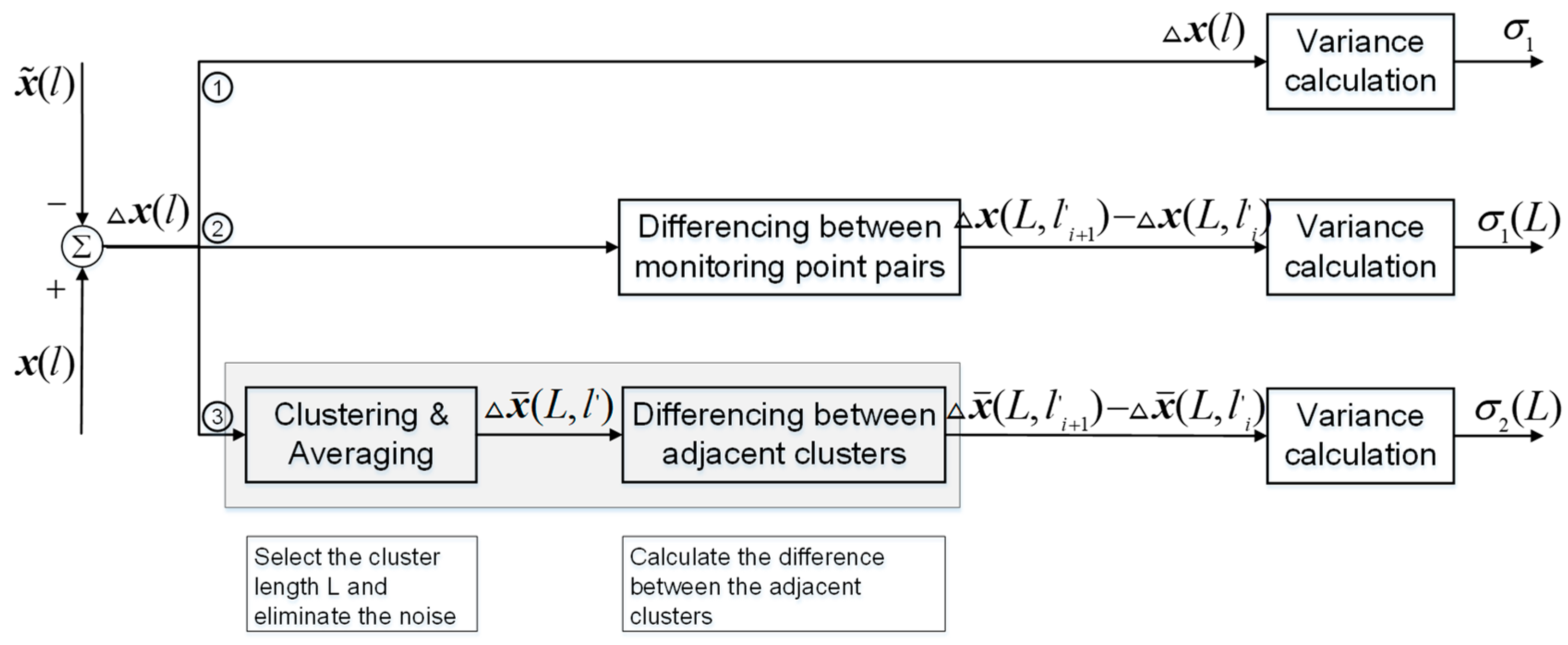

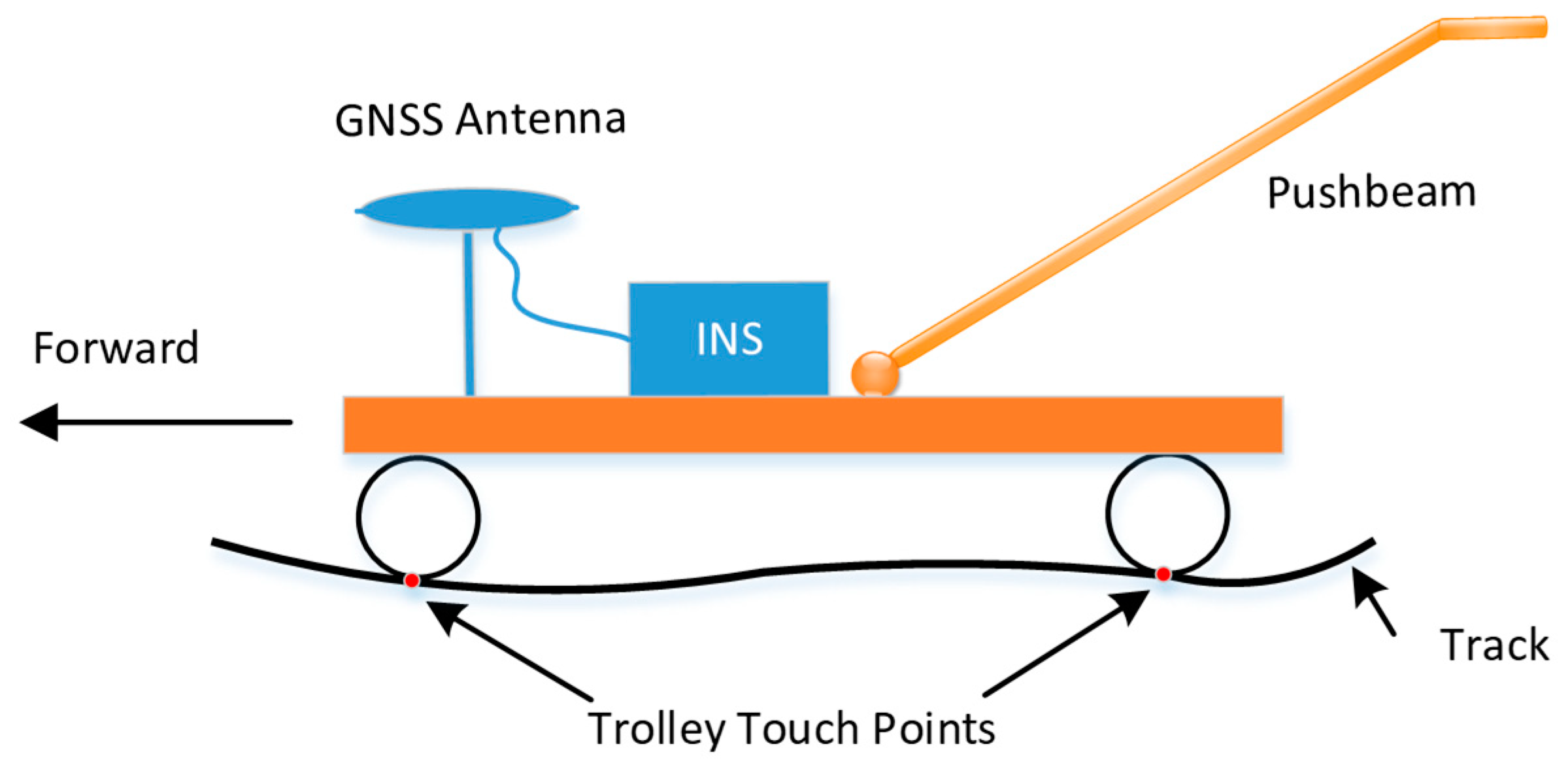
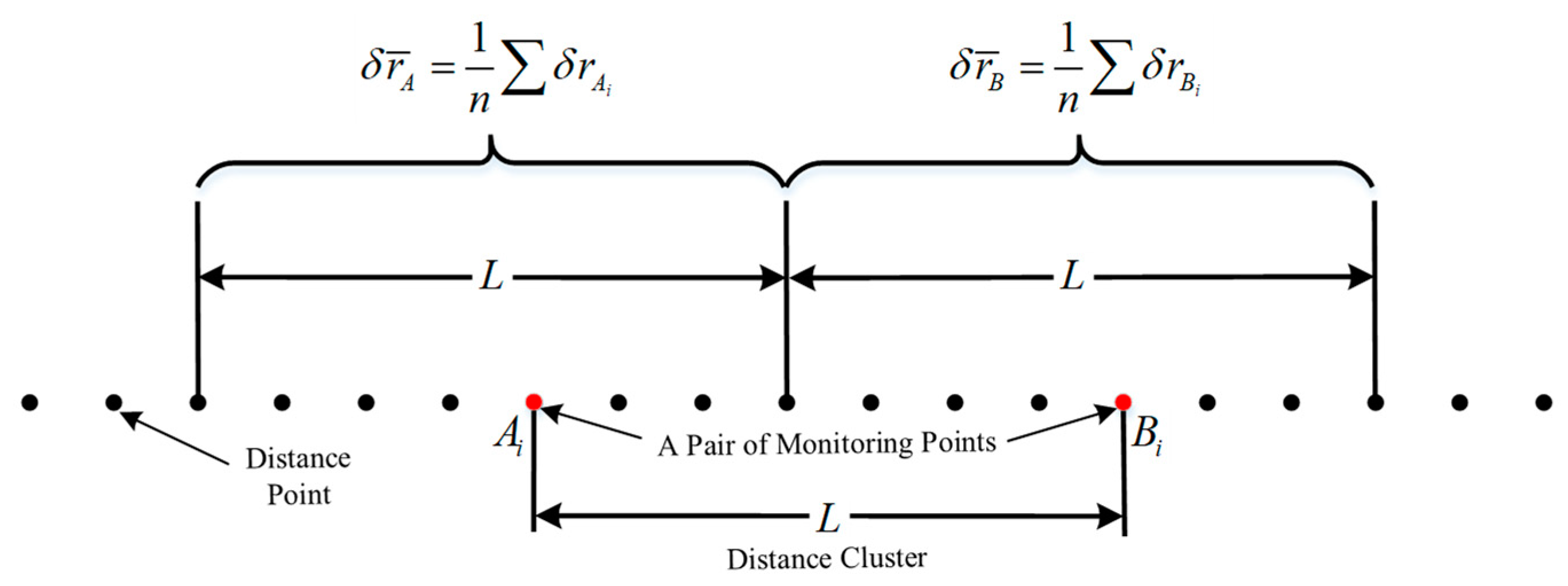
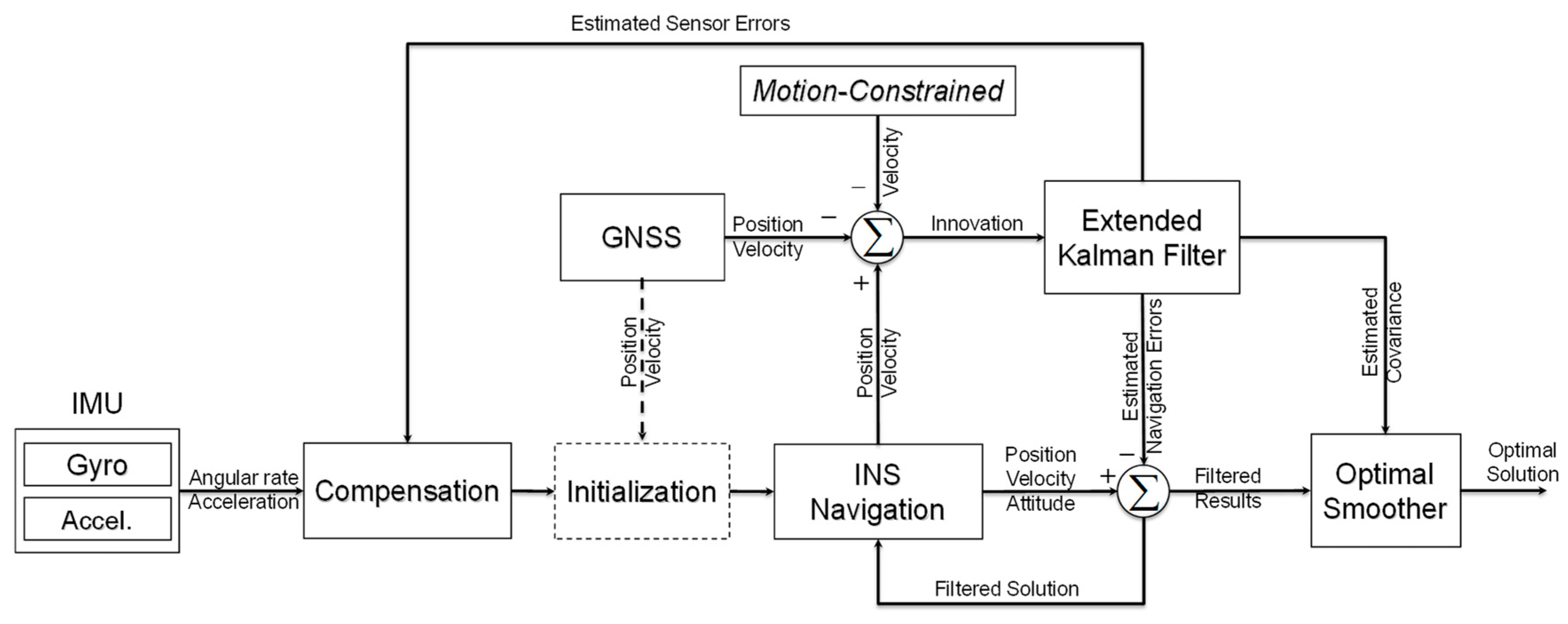


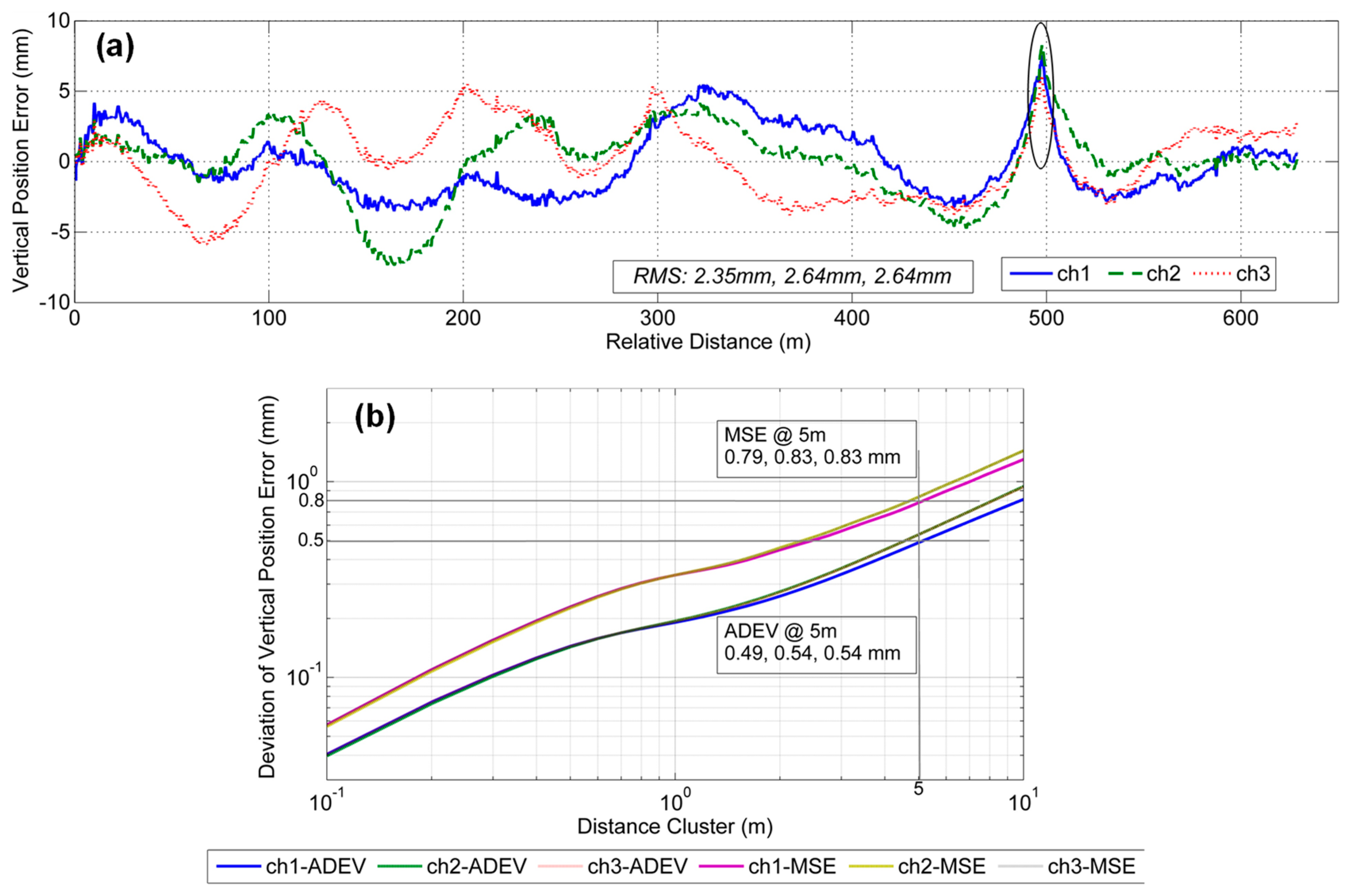
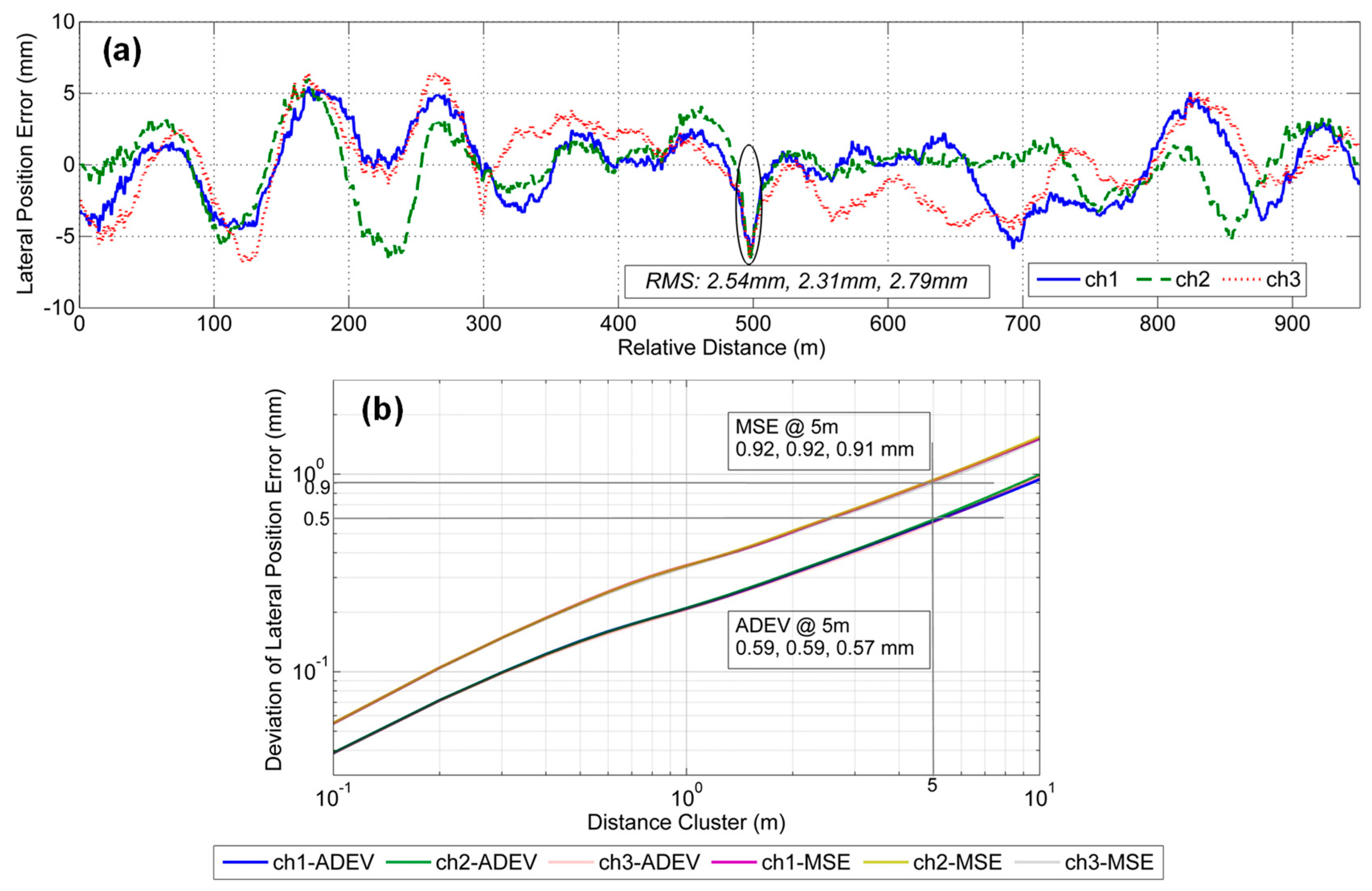
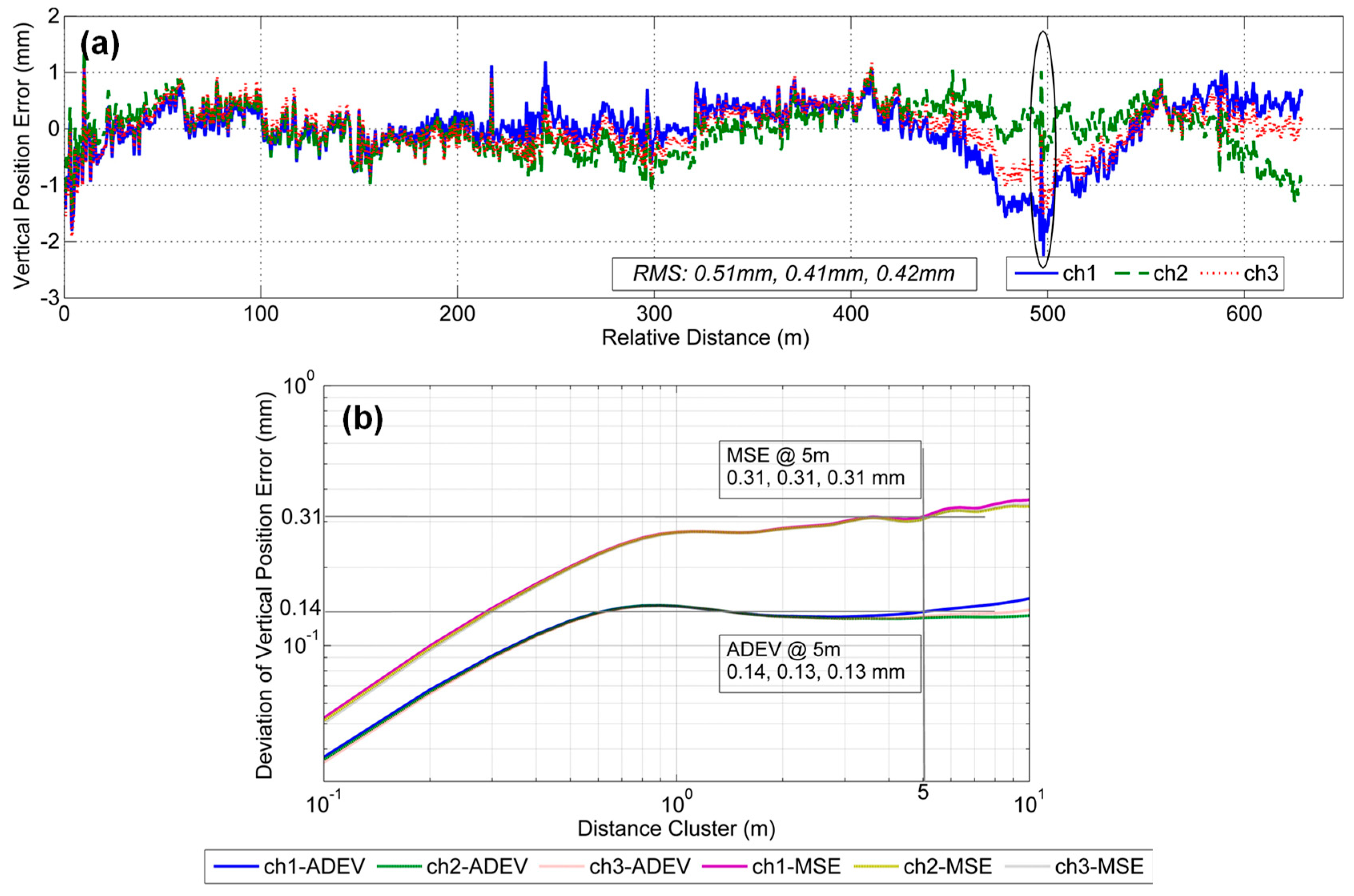
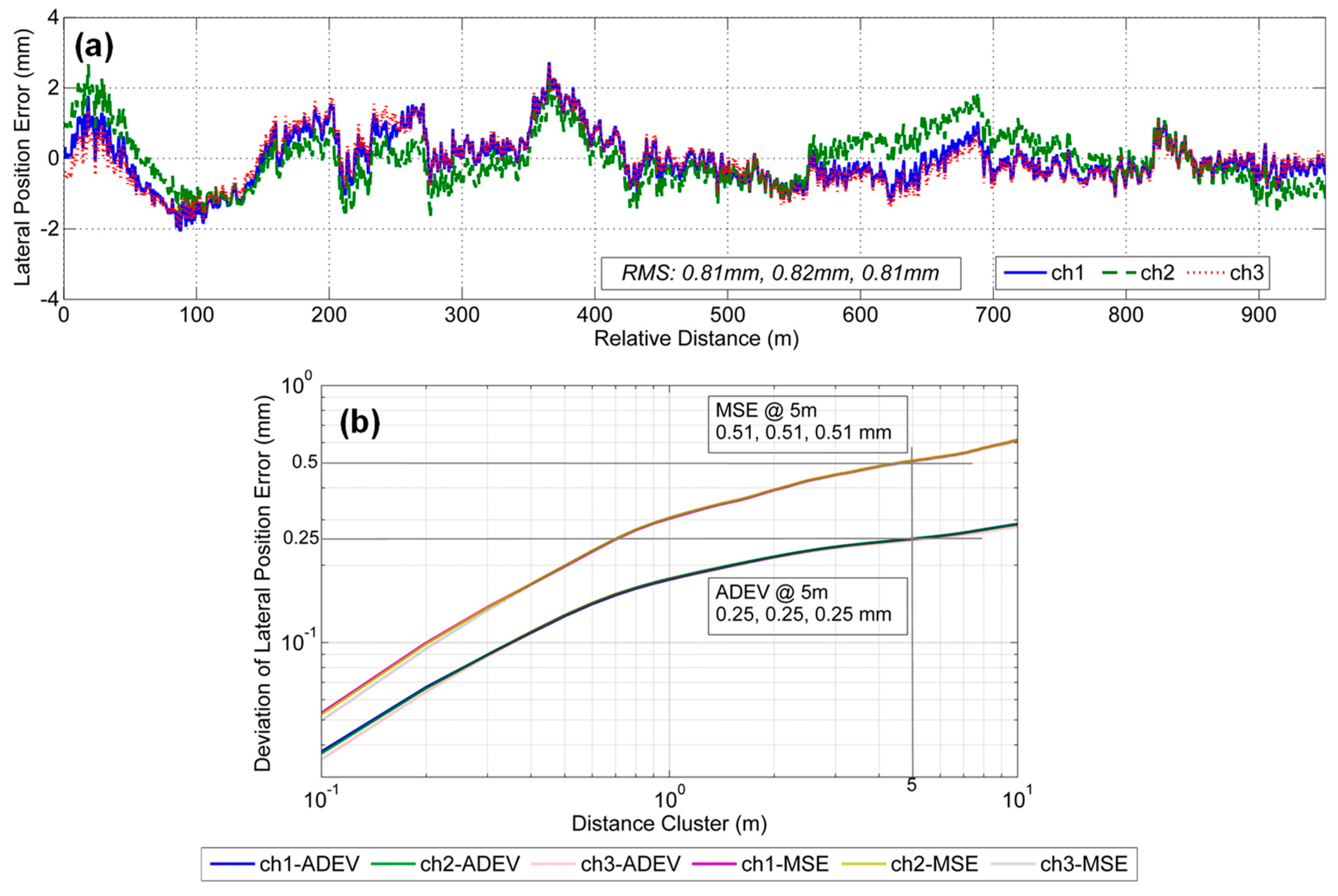
| Parameter | Wave | Chord Length (m) | Distance of the Monitoring Points (m) | Allowable Deviation (mm) |
|---|---|---|---|---|
| Track irregularity | Shortwave | 30 | 5 | 2 |
| Longwave | 300 | 150 | 10 |
| Sensor | Major Technique Index | ||
|---|---|---|---|
| IMU | Data rate: 200 Hz | ||
| Gyroscope | In-run bias stability | 0.01 deg/h | |
| Scale factor | 10 ppm | ||
| Accelerometer | In-run bias stability | 10 µg | |
| Scale factor | 10 ppm | ||
| GNSS | GPS + GLONASS, dual frequency | ||
| Sampling rate: 1 Hz | |||
| Position accuracy: 2 cm + 1 ppm (RMS) in RT-2 LITE mode | |||
| Integration Mode | Evaluation Method | Relative Accuracy (mm) | Threshold Values (mm) | |
|---|---|---|---|---|
| Vertical | Lateral | |||
| GNSS/INS mode | MSE | 0.82 | 0.92 | 0.67 |
| ADEV | 0.52 | 0.58 | 0.16 | |
| Motion-constrained GNSS/INS mode | MSE | 0.31 | 0.51 | 0.67 |
| ADEV | 0.13 | 0.25 | 0.16 | |
© 2019 by the authors. Licensee MDPI, Basel, Switzerland. This article is an open access article distributed under the terms and conditions of the Creative Commons Attribution (CC BY) license (http://creativecommons.org/licenses/by/4.0/).
Share and Cite
Zhang, Q.; Chen, Q.; Niu, X.; Shi, C. Requirement Assessment of the Relative Spatial Accuracy of a Motion-Constrained GNSS/INS in Shortwave Track Irregularity Measurement. Sensors 2019, 19, 5296. https://doi.org/10.3390/s19235296
Zhang Q, Chen Q, Niu X, Shi C. Requirement Assessment of the Relative Spatial Accuracy of a Motion-Constrained GNSS/INS in Shortwave Track Irregularity Measurement. Sensors. 2019; 19(23):5296. https://doi.org/10.3390/s19235296
Chicago/Turabian StyleZhang, Quan, Qijin Chen, Xiaoji Niu, and Chuang Shi. 2019. "Requirement Assessment of the Relative Spatial Accuracy of a Motion-Constrained GNSS/INS in Shortwave Track Irregularity Measurement" Sensors 19, no. 23: 5296. https://doi.org/10.3390/s19235296
APA StyleZhang, Q., Chen, Q., Niu, X., & Shi, C. (2019). Requirement Assessment of the Relative Spatial Accuracy of a Motion-Constrained GNSS/INS in Shortwave Track Irregularity Measurement. Sensors, 19(23), 5296. https://doi.org/10.3390/s19235296





